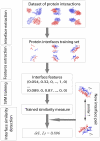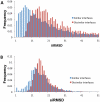Structural similarity and classification of protein interaction interfaces
- PMID: 21589874
- PMCID: PMC3093400
- DOI: 10.1371/journal.pone.0019554
Structural similarity and classification of protein interaction interfaces
Abstract
Interactions between proteins play a key role in many cellular processes. Studying protein-protein interactions that share similar interaction interfaces may shed light on their evolution and could be helpful in elucidating the mechanisms behind stability and dynamics of the protein complexes. When two complexes share structurally similar subunits, the similarity of the interaction interfaces can be found through a structural superposition of the subunits. However, an accurate detection of similarity between the protein complexes containing subunits of unrelated structure remains an open problem. Here, we present an alignment-free machine learning approach to measure interface similarity. The approach relies on the feature-based representation of protein interfaces and does not depend on the superposition of the interacting subunit pairs. Specifically, we develop an SVM classifier of similar and dissimilar interfaces and derive a feature-based interface similarity measure. Next, the similarity measure is applied to a set of 2,806×2,806 binary complex pairs to build a hierarchical classification of protein-protein interactions. Finally, we explore case studies of similar interfaces from each level of the hierarchy, considering cases when the subunits forming interactions are either homologous or structurally unrelated. The analysis has suggested that the positions of charged residues in the homologous interfaces are not necessarily conserved and may exhibit more complex conservation patterns.
Conflict of interest statement
Figures







Similar articles
-
Charged residues at protein interaction interfaces: unexpected conservation and orchestrated divergence.Protein Sci. 2011 Jul;20(7):1275-84. doi: 10.1002/pro.655. Epub 2011 Jun 2. Protein Sci. 2011. PMID: 21563227 Free PMC article.
-
Encoding the space of protein-protein binding interfaces by artificial intelligence.Comput Biol Chem. 2024 Jun;110:108080. doi: 10.1016/j.compbiolchem.2024.108080. Epub 2024 Apr 18. Comput Biol Chem. 2024. PMID: 38643609
-
Global and local structural similarity in protein-protein complexes: implications for template-based docking.Proteins. 2013 Dec;81(12):2137-42. doi: 10.1002/prot.24392. Epub 2013 Oct 17. Proteins. 2013. PMID: 23946125 Free PMC article.
-
Prediction of protein-protein interactions: unifying evolution and structure at protein interfaces.Phys Biol. 2011 Jun;8(3):035006. doi: 10.1088/1478-3975/8/3/035006. Epub 2011 May 13. Phys Biol. 2011. PMID: 21572173 Review.
-
Structural motifs at protein-protein interfaces: protein cores versus two-state and three-state model complexes.Protein Sci. 1997 Sep;6(9):1793-805. doi: 10.1002/pro.5560060901. Protein Sci. 1997. PMID: 9300480 Free PMC article. Review.
Cited by
-
Composite structural motifs of binding sites for delineating biological functions of proteins.PLoS One. 2012;7(2):e31437. doi: 10.1371/journal.pone.0031437. Epub 2012 Feb 8. PLoS One. 2012. PMID: 22347478 Free PMC article.
-
PBSword: a web server for searching similar protein-protein binding sites.Nucleic Acids Res. 2012 Jul;40(Web Server issue):W428-34. doi: 10.1093/nar/gks527. Epub 2012 Jun 11. Nucleic Acids Res. 2012. PMID: 22689645 Free PMC article.
-
Review of computational methods for virus-host protein interaction prediction: a case study on novel Ebola-human interactions.Brief Funct Genomics. 2018 Nov 26;17(6):381-391. doi: 10.1093/bfgp/elx026. Brief Funct Genomics. 2018. PMID: 29028879 Free PMC article. Review.
-
Sequence and Structure Properties Uncover the Natural Classification of Protein Complexes Formed by Intrinsically Disordered Proteins via Mutual Synergistic Folding.Int J Mol Sci. 2019 Nov 1;20(21):5460. doi: 10.3390/ijms20215460. Int J Mol Sci. 2019. PMID: 31683980 Free PMC article.
References
-
- Alberts B. Essential cell biology : an introduction to the molecular biology of the cell. New York: Garland Pub; 1998. p. 1 v. (various pagings).
-
- Aloy P, Ceulemans H, Stark A, Russell RB. The relationship between sequence and interaction divergence in proteins. J Mol Biol. 2003;332:989–998. - PubMed
-
- Belyaeva OV, Korkina OV, Stetsenko AV, Kim T, Nelson PS, et al. Biochemical properties of purified human retinol dehydrogenase 12 (RDH12): catalytic efficiency toward retinoids and C9 aldehydes and effects of cellular retinol-binding protein type I (CRBPI) and cellular retinaldehyde-binding protein (CRALBP) on the oxidation and reduction of retinoids. Biochemistry. 2005;44:7035–7047. - PMC - PubMed
-
- Abbasi I, Githure J, Ochola JJ, Agure R, Koech DK, et al. Diagnosis of Wuchereria bancrofti infection by the polymerase chain reaction employing patients' sputum. Parasitol Res. 1999;85:844–849. - PubMed
Publication types
MeSH terms
Substances
LinkOut - more resources
Full Text Sources

